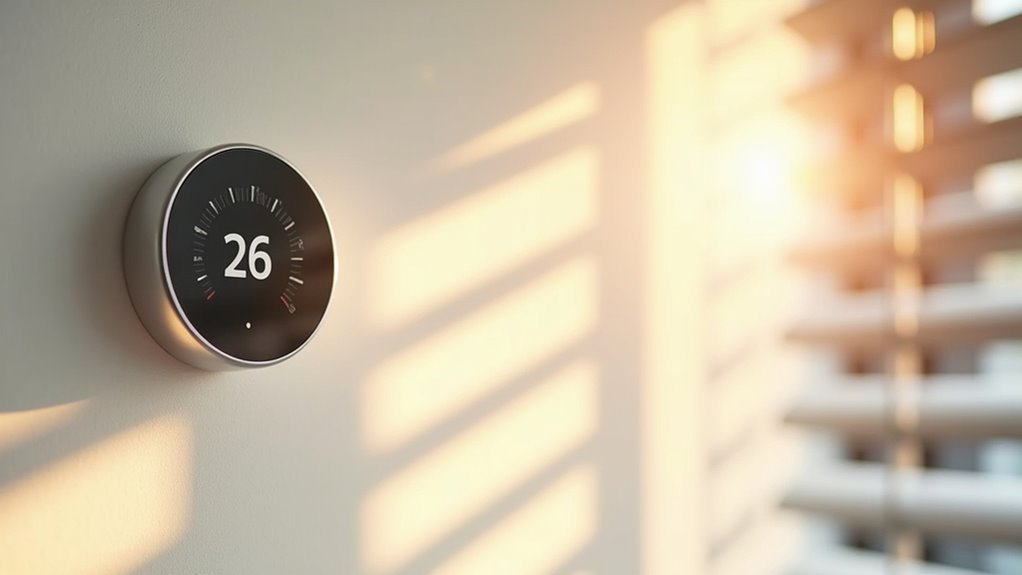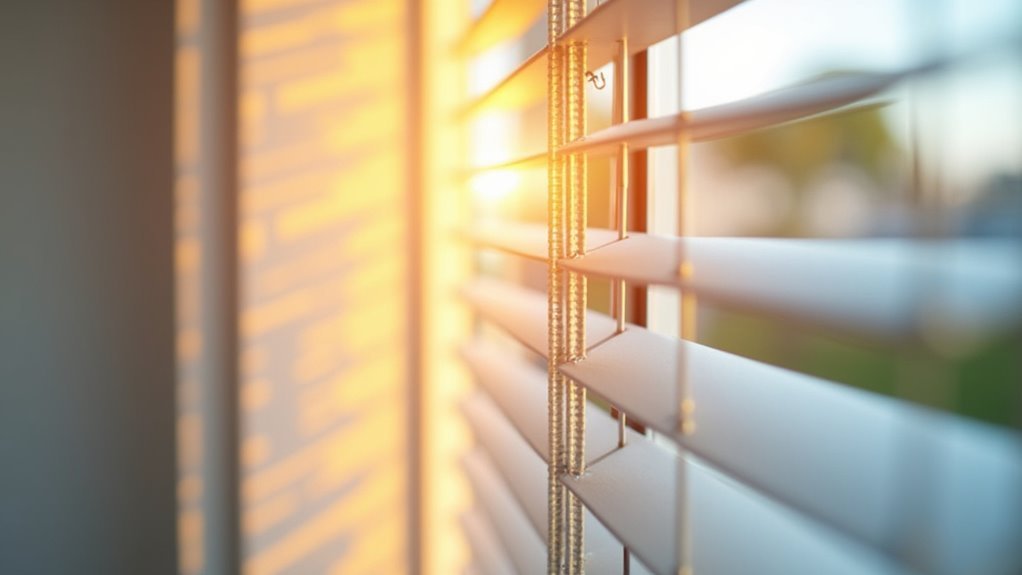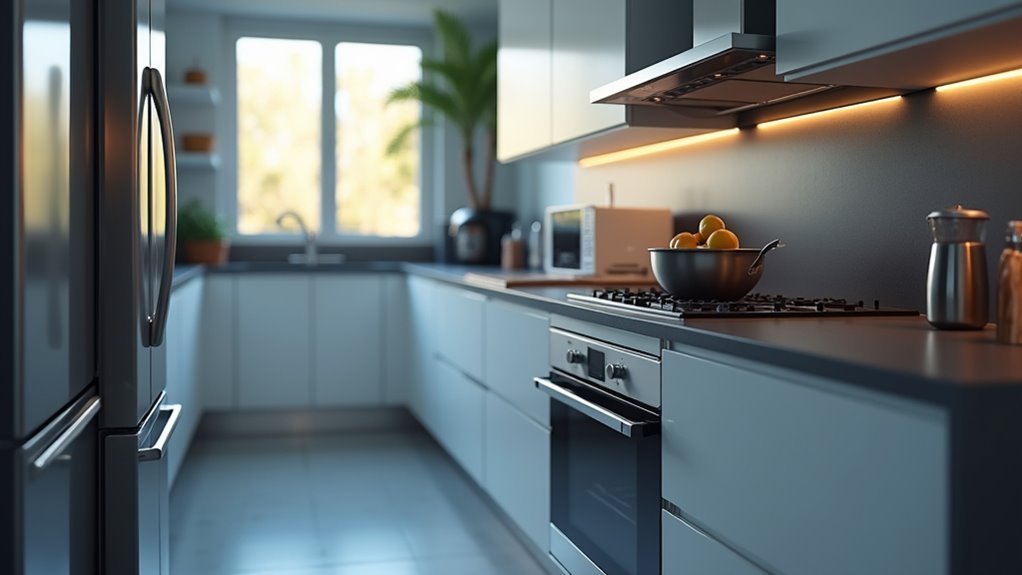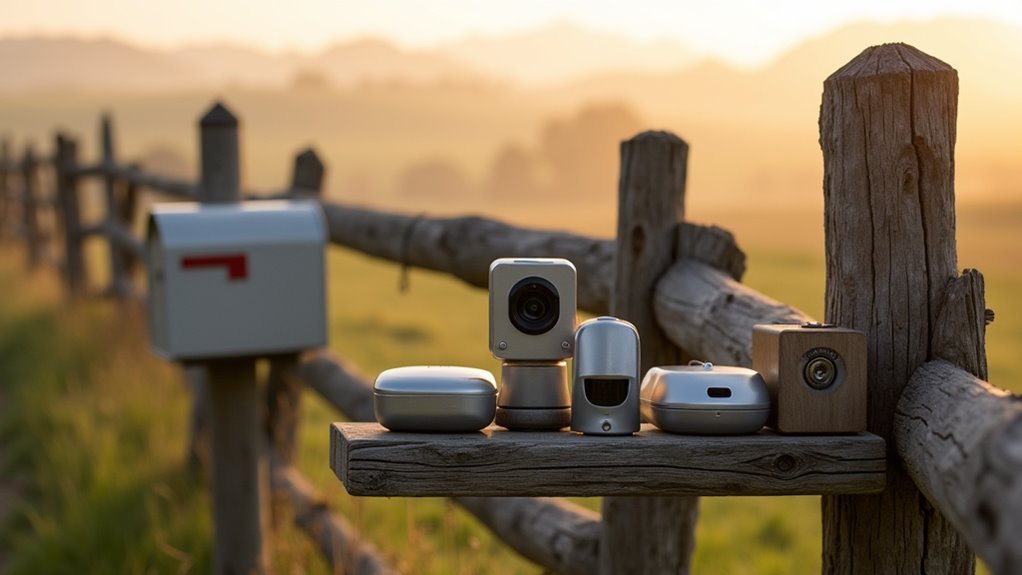You’ve probably noticed your automated blinds closing on hot days, but do you know exactly what temperature triggers that response? Most systems default to 75-80°F, though you’ll want to customize this based on your home’s orientation, insulation, and personal comfort preferences. The trick isn’t just setting one magic number—it’s understanding how outdoor temperature, indoor conditions, and sunlight intensity work together to create the perfect automated response that saves energy while keeping you comfortable.
Understanding Temperature Thresholds for Blind Automation

When setting up automated blinds, you’ll need to establish temperature thresholds that trigger the system to open or close based on your comfort preferences and energy efficiency goals.
Most homeowners start with a baseline of 70°F, which provides ideal comfort while maximizing energy savings. However, you can customize these settings based on your specific needs.
For particularly hot climates, you might set higher thresholds around 75°F or 80°F to prevent overheating while maintaining indoor comfort.
Your automated blinds will respond more effectively when you incorporate smart thermostats for precise temperature monitoring.
Remember to adjust these thresholds seasonally, as varying weather conditions throughout the year require different approaches to maintain consistent comfort and efficiency in your home.
Setting Up Temperature Sensors for Smart Blinds
You’ll need to strategically position your temperature sensors away from direct sunlight and heat sources to get accurate readings that truly reflect your room’s ambient conditions.
Once you’ve found the ideal location, configure your temperature threshold to trigger blind automation—start with 73°F for testing during peak heat periods to guarantee reliable activation.
Remember that your system will only respond when temperatures cross from below to above your set threshold, so you’ll want to fine-tune this setting based on your specific comfort preferences and room characteristics.
Sensor Placement Strategies
Strategic sensor placement forms the foundation of an effective automated blind system, directly impacting how accurately your smart blinds respond to temperature changes.
You’ll want to position sensors at roughly 5 feet from the ground to capture representative room temperature while avoiding direct sunlight and heat sources that skew readings.
For larger spaces, install multiple sensors to account for temperature variations across different zones. This allows your automated window coverings to respond appropriately to actual conditions rather than localized hot or cold spots.
Place sensors near windows and draft-prone areas since these locations greatly influence temperature fluctuations.
Controlling blinds based on accurate readings requires regular sensor calibration and maintenance. This strategic approach guarantees your system triggers blinds precisely when temperature thresholds are reached.
Temperature Threshold Configuration
Once you’ve positioned your sensors strategically, configuring the right temperature thresholds becomes critical for ideal blind automation performance.
Set your temperature thresholds between 70°F and 75°F based on your specific environment and comfort preferences. These automated blinds will respond effectively when temperatures exceed your configured limits.
Integrate temperature sensors with home automation systems like Zigbee or Z-Wave for seamless communication.
Configure sensors to report data every 5 minutes, ensuring timely activation when thresholds are breached. For testing purposes, consider setting higher temperature triggers since automation won’t activate if current temperatures already exceed your threshold when sensors first report.
Remember to regularly adjust your settings seasonally.
Summer thresholds might differ from winter requirements, so periodic calibration optimizes your system’s responsiveness and energy efficiency throughout the year.
Optimal Temperature Ranges for Energy Efficiency

When you’re optimizing your home’s energy efficiency, maintaining the right temperature ranges becomes essential for maximizing savings while ensuring comfort.
During winter months, you’ll want to keep your thermostat between 68°F and 72°F for ideal efficiency. In summer, adjusting to 75°F-78°F reduces cooling demands considerably.
Your motorized blind system should automatically close when outdoor temperatures exceed 80°F, blocking direct sunlight that can raise indoor temperatures by up to 20°F.
This simple action reduces your air conditioning workload considerably. For every degree above 72°F in summer, you’ll face approximately 3% higher energy costs.
Programming Temperature-Based Blind Controls
Programming your temperature-based blind controls requires setting specific thresholds that trigger automatic responses to changing conditions. You’ll want to configure your system to open and close blinds when indoor temperatures reach 70°F or higher for ideal comfort.
| Sensor Type | Temperature Threshold | Lux Threshold | Action | Season |
|---|---|---|---|---|
| e-Air sensor | 70°F | 1,000 lux | Close blinds | Summer |
| e-Air sensor | 68°F | 800 lux | Open blinds | Winter |
| e-Air sensor | 72°F | 1,200 lux | Close blinds | Spring |
| e-Air sensor | 69°F | 900 lux | Partial close | Fall |
| e-Air sensor | 75°F | 1,500 lux | Full close | Peak summer |
Environmental sensors like the e-Air provide high quality monitoring of both temperature and illuminance. You should regularly adjust these trigger settings seasonally and test their effectiveness to maximize energy efficiency.
Combining Light and Temperature Triggers

Building on individual temperature thresholds, you’ll achieve more precise control by integrating both light and temperature sensors into a unified automation system.
This dual-trigger approach makes sense because it addresses multiple comfort factors simultaneously. For example, when your indoor temperature exceeds 73°F and illuminance levels climb above 1,000 lux, the system will automatically close the blinds to reduce heat gain and prevent glare.
Environmental sensors like the e-Air sensor enable real-time monitoring of both conditions, making your system more responsive to changing weather.
During sunny days, when lux levels reach between 5 and 6,500, combining light and temperature data guarantees your blinds respond dynamically. This integration optimizes energy efficiency while maintaining consistent indoor comfort throughout the day.
Seasonal Temperature Adjustments for Automated Blinds
While basic temperature triggers provide year-round automation, seasonal adjustments transform your blind system into a truly intelligent climate control solution.
You’ll want to program different thresholds for summer and winter months. During hot seasons, set blinds to partially close on sunny days above 75°F, allowing breeze circulation while blocking harsh rays. On extremely hot days, they’ll fully close to maintain comfort.
Winter programming should open blinds during sunny periods to maximize solar heating, reducing your energy costs.
Your smart home interface is best viewed with JavaScript functionality, and seasonal scheduling features are ideally viewed with JavaScript enabled for seamless programming.
You can create pre-programmed schedules tailored to specific temperature ranges, ensuring your blinds automatically adapt to seasonal weather patterns while maximizing both comfort and energy efficiency throughout the year.
Indoor Vs Outdoor Temperature Monitoring Systems
Effective temperature-based automation depends on choosing the right monitoring approach for your specific needs.
Indoor temperature monitoring systems use sensors throughout your home to provide real-time data, ensuring your automated blinds respond quickly to internal climate fluctuations. You can integrate these systems with smart home devices to trigger blinds when temperatures exceed set thresholds, like 75°F.
Smart sensors positioned around your home deliver instant temperature readings, enabling blinds to automatically adjust when indoor heat levels reach your preferred settings.
Outdoor temperature monitoring relies on weather stations that incorporate humidity, wind speed, and sunlight data for thorough control. These sensors trigger blinds to close when external temperatures rise, reducing heat gain and improving energy efficiency.
Combining both indoor and outdoor temperature data enhances your automated blinds’ performance, allowing adjustments based on direct sunlight exposure and overall thermal environment conditions.
Temperature Trigger Calibration and Fine-Tuning
You’ll need to set your automated blinds’ temperature triggers at the right thresholds to maximize their effectiveness in your home’s unique environment.
Most systems work best when calibrated to activate around 75°F, though you might find better results testing values between 70°F and 80°F based on your insulation quality and personal comfort preferences.
Remember to adjust these settings seasonally since your cooling needs change dramatically between summer and winter months.
Optimal Temperature Thresholds
Setting the right temperature thresholds forms the foundation of any effective automated blind system.
You’ll want to establish ideal ranges between 70°F to 85°F, though your specific indoor climate and comfort preferences will guide these decisions.
Consider implementing these strategic approaches:
- Seasonal adjustments – Use lower thresholds in summer and higher ones in winter to maximize solar heating benefits.
- Gradual closure settings – Set 75°F for partial closure and 85°F for complete closure to enhance comfort.
- Energy efficiency focus – Proper timing during peak heat can reduce your cooling costs by up to 30%.
- Regular sensor calibration – Maintain accuracy to prevent system failures during critical high-heat events.
Fine-tuning these thresholds based on seasonal variations guarantees your automated blinds respond effectively to changing conditions.
Seasonal Adjustment Methods
When seasonal changes shift your home’s thermal dynamics, recalibrating your automated blind triggers becomes essential for maintaining peak performance year-round.
During summer months, you’ll want to set your blinds to close automatically when indoor temperatures exceed 75°F, reducing cooling costs while maintaining comfort.
Winter requires the opposite approach—program your blinds to open during sunny days when temperatures climb above 30°F, maximizing solar heating and decreasing heating system dependency.
Fine-tune your system by monitoring sensor data every five minutes, ensuring timely responses to temperature fluctuations.
Remember to adjust triggers based on your region’s specific climate patterns, as seasonal temperature variations differ greatly across geographic areas.
This targeted calibration optimizes energy efficiency throughout the year.
Smart Thermostat Integration With Automated Blinds
As smart home technology advances, integrating your automated blinds with a smart thermostat creates a powerful climate control system that responds intelligently to real-time temperature changes.
Your smart thermostat can automatically trigger blinds to close when temperatures exceed your preset threshold—typically around 70°F—preventing unwanted heat gain during hot days. This seamless coordination enhances energy efficiency while maintaining ideal comfort levels.
Key integration benefits include:
- Customized routines that synchronize blind operation with thermostat settings for personalized comfort
- Occupancy-based control using sensors to adjust blinds only when spaces are occupied
- Data-driven refinement allowing fine-tuning of temperature triggers based on seasonal patterns
- Real-time responsiveness ensuring immediate adjustments to changing environmental conditions
You can analyze thermostat data to refine automation settings, adapting your system to seasonal changes and personal preferences for maximum efficiency.
Weather-Based Temperature Control Strategies
You’ll want to establish seasonal temperature thresholds that adapt your automated blinds to changing weather patterns throughout the year.
Setting different triggers for summer and winter conditions guarantees your blinds respond appropriately when outdoor temperatures reach 85°F in hot months or drop considerably during colder periods.
Multi-factor weather integration takes this further by combining temperature data with humidity, wind speed, and precipitation forecasts to create detailed control strategies that maximize both comfort and energy efficiency.
Seasonal Temperature Thresholds
Since outdoor temperatures fluctuate dramatically throughout the year, your automated blinds need different temperature thresholds for each season to maintain ideal indoor comfort.
During summer months, you’ll want your blinds closing when indoor temperatures exceed 75°F, or when outdoor readings hit 85°F to prevent heat buildup.
Winter programming should keep blinds open on sunny days to capture beneficial solar gain.
Here’s how to optimize your seasonal settings:
- Spring/Fall: Raise closure temperatures to account for changing sunlight angles and moderate heating needs
- Summer: Set aggressive thresholds at 75-80°F indoors to reduce cooling costs
- Winter: Keep blinds open during daylight hours for maximum solar heat gain
- Partial closure: Use 72°F triggers for maintaining airflow while blocking direct sunlight
Adjusting these thresholds seasonally guarantees year-round efficiency and comfort.
Multi-Factor Weather Integration
While temperature-based triggers form the foundation of automated blind control, modern systems excel when they incorporate multiple weather data sources simultaneously.
You’ll achieve ideal indoor climate control by integrating temperature, sunlight, and wind sensors into your automation system. When your indoor temperature exceeds 75°F, you can program blinds to close automatically, reducing air conditioning demands.
Light sensors measuring illuminance above 1,000 lux will trigger closure during peak sunlight hours, preventing glare and excessive heat buildup. Real-time weather station data allows your system to anticipate forecasted temperature changes and adjust accordingly.
Temperature Sensor Placement for Maximum Effectiveness
Proper sensor placement determines whether your automated blinds respond accurately to temperature changes throughout your home.
Strategic sensor positioning is the foundation of reliable automated blind systems that truly respond to your home’s thermal environment.
You’ll need to strategically position these sensors to capture real thermal conditions rather than misleading readings.
Here are key placement strategies for ideal performance:
- Position sensors in direct sunlight areas – This captures solar gain effects that actually impact your indoor comfort and triggers appropriate blind responses.
- Keep sensors away from heat sources – Radiators, electronics, and appliances create false readings that cause improper blind adjustments.
- Install at occupant height – Mount sensors around 5 feet from the floor to represent average human experience levels.
- Use multiple sensors in large spaces – Capture temperature variations across different zones for precise localized automation.
Regular calibration and maintenance guarantee sensors stay accurate, as dust and debris compromise their reliability over time.
Troubleshooting Temperature-Triggered Blind Systems
When your automated blind system fails to respond correctly to temperature changes, the culprit often lies in misconfigured trigger thresholds or inaccurate sensor readings.
First, verify your temperature triggers aren’t already exceeded—if your thermostat reads 73°F but your trigger’s set lower, blinds won’t activate. Check that entity IDs and automation conditions are properly configured in your system settings.
Monitor your sensor’s reporting frequency since some update every 5 minutes, requiring automation settings that accommodate these intervals.
Test your thermostat’s accuracy by comparing readings with a separate thermometer. For troubleshooting, try turning off air conditioning to let indoor temperatures rise naturally, which helps verify if your automation responds correctly to gradual temperature changes rather than sudden fluctuations.
Advanced Temperature Control Automation Rules
Once you’ve resolved basic temperature automation issues, you can implement sophisticated rules that respond intelligently to varying thermal conditions.
These advanced configurations let you create dynamic responses that optimize comfort while maximizing energy efficiency throughout different seasons and weather patterns.
You can configure multi-layered automation rules that consider various factors:
- Progressive closing triggers – Set blinds to partially close at 80°F for ventilation, then fully close at 85°F when combined with high illuminance levels above 1,200 lux
- Seasonal adjustments – Program rules to open blinds below 60°F during colder months for natural solar heating
- Change-based activation – Ascertain triggers activate only when temperature changes occur, not when values already exceed thresholds
- Heat reduction protocols – Automatically close blinds at 75°F to minimize heat gain during hot days
Enhancing Comfort Through Temperature-Responsive Blinds
You’ll find that setting ideal temperature thresholds for your automated blinds creates a seamless comfort experience that responds to your home’s specific needs.
When you integrate multiple temperature sensors throughout different rooms, you’re able to establish precise control zones that react independently to varying thermal conditions.
This multi-sensor approach guarantees your blinds adjust automatically when temperatures hit your predetermined comfort levels, maintaining consistent indoor climates without any manual intervention.
Optimal Temperature Thresholds
As indoor temperatures climb beyond your comfort zone, automated blinds equipped with ideal temperature thresholds become your first line of defense against excessive heat.
You’ll want to program your blinds to close when temperatures exceed 75°F for general comfort, though setting a lower 70°F threshold prevents overheating during intense sunlight hours.
Your smart blinds’ effectiveness depends on these key factors:
- Real-time monitoring through integrated temperature sensors for prompt responses to sudden heat spikes
- Regional climate adjustments that account for your local weather patterns
- Seasonal threshold modifications to maintain year-round energy efficiency
- Customizable triggers that let you fine-tune comfort levels while reducing air conditioning dependency
You’ll find these best settings create a perfectly balanced indoor environment.
Multi-Sensor Control Integration
Beyond temperature alone, multi-sensor integration transforms your automated blinds into a sophisticated climate control system that responds to extensive environmental data.
You’ll achieve peak comfort by combining temperature and light sensors, allowing your blinds to react intelligently to both heat and glare conditions. When you program your system to close blinds at 70°F while simultaneously monitoring illuminance levels, you’re creating a dual-response automation that maximizes energy efficiency.
Smart home systems utilizing Zigbee battery-powered sensors provide reliable communication with 5-minute reporting intervals, ensuring timely adjustments as conditions fluctuate.
You can fine-tune automation settings by analyzing combined temperature and light data, creating personalized comfort profiles. This integration prevents overheating while managing sunlight exposure, delivering seamless indoor climate control that adapts to your specific environmental needs.
Frequently Asked Questions
Does Having Your Blinds Open Make Your Room Hotter?
Yes, you’ll notice your room gets considerably hotter with open blinds during peak sunlight hours. You’re allowing solar heat gain that can raise indoor temperatures by 10-20°F, forcing you to use more cooling.
Can You Make Your Blinds Automatic?
You can make your blinds automatic by installing DIY motorized kits that retrofit existing blinds. These systems connect to Wi-Fi, integrate with smart home devices, and operate via smartphone apps or voice commands.
What Are Automated Blinds?
Automated blinds are motorized window coverings you control remotely through apps, wall switches, or voice commands. They’re battery-powered or hardwired, integrating with smart home systems for scheduled operations and energy efficiency.





Leave a Reply